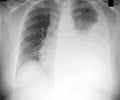Richard Wenzel and his colleagues from United Kingdom have found a new antibiotic tigecycline which belongs to the family of new generation of Tetracycline known as Glycycline
Richard Wenzel and his colleagues from United Kingdom have found a new antibiotic tigecycline which belongs to the family of new generation of Tetracycline known as Glycycline.
Due to indiscriminate use of antibiotics there is an increased incidence of antibiotic resistance shown by many organisms. Staphylococcus aureus is a gram positive bacteria, which is a major cause of concern as it causes most of the nosocomial infections in hospital. Staphylococcus aureus as shown an increased resistance to many drugs including the different analogues of Tetracycline and Vancomycin.Drug – Tetracycline: Tetracyclines were first discovered 50 years ago and were found to have broad spectrum antibacterial activity against both gram positive and gram negative bacteria. Following their initial widespread use, a high incidence of tetracycline resistance among many bacteria has led to tetracyclines being relegated to second- or third-line therapy. As increases resistance to tetracycline have developed there are lot of approaches to restore the potential of tetracyclines as broad-spectrum antibiotics, systematic searches for tetracycline analogues with activity against both tetracycline-susceptible and tetracycline-resistant organisms were performed in the early 1990s which has led to the identification of the glycylcyclines, including tigecycline.
Properties of Tigecycline: Tigecycline was discovered by introducing substituents at position 9 of minocycline resulted in compounds that not only had activity typical of earlier tetracyclines, but also displayed activity against bacteria containing resistant genes.
Tigecycline inhibits bacterial protein synthesis by binding to the 30S ribosomal subunit. Tigecycline blocks entry of amino-acyl tRNA molecules into the A site of the ribosome, preventing incorporation of amino-acid residues into elongating peptide chains. Tetracycline drug resistance in bacteria occurred due to mechanisms of ribosomal protection and active drug efflux. But, the new generation tetracycline - Tigecycline is not affected by either of these mechanisms.
Clinical studies and FDA approval: Two clinical studies proving the active effect of Tigecycline as lead to FDA approval of Tigecycline for treatment of bacterial infections.
Study I: Tigecycline was tested on patients with complicated skin and skin-structure infections.
Advertisement
Study II: Tigecycline was tested in patients with complicated intra-abdominal infections
Advertisement
Tigecycline has great promise as a new therapeutic agent against important pathogens and is highly active against both nosocomial and Methicillin Resistant S. aureus strains (MRSA), vancomycin resistant E. faecium and penicillin resistant strains of S. pneumoniae. Though, Tigecycline's structure is similar to that of the tetracyclines but additional structural elements increase its potency and impede the mechanisms of bacterial resistance associated with the tetracyclines.
Source: Nature Reviews Drug Discovery.







